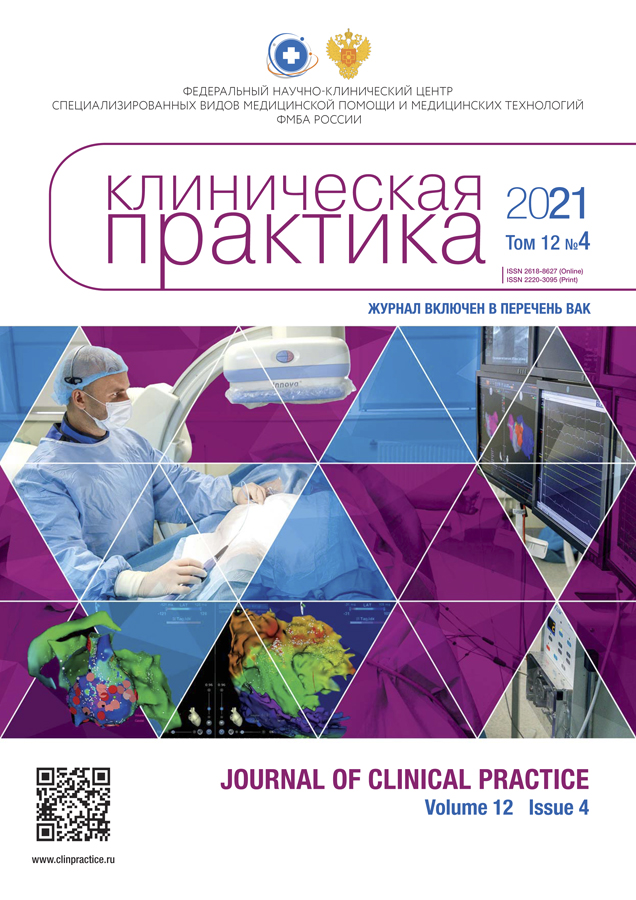Clinical characteristics of patients with chronic migraine, depending on their personality profile
- Authors: Baiushkina L.I.1,2
-
Affiliations:
- Alexander Vein Headache Clinic
- Sechenov First Moscow State Medical Univesity (Sechenov Univesity)
- Issue: Vol 12, No 4 (2021)
- Pages: 38-43
- Section: Original Study Articles
- URL: https://journals.rcsi.science/clinpractice/article/view/81061
- DOI: https://doi.org/10.17816/clinpract81061
- ID: 81061
Cite item
Full Text
Abstract
Background: Chronic migraine is a highly disabling neurological disease that is difficult to treat. The success of the therapeutic management depends, in part, on the psychosocial and personal factors.
Aims: To evaluate the clinical characteristics of patients suffering from chronic migraine, depending on the prevailing coping strategy of the individual.
Methods: 104 patients with an established diagnosis of chronic migraine were examined, all of them underwent а clinical and neurological examination and questionnaire testing.
Results: In the studied group of patients, active behavioral coping strategies (a strategy for solving the problem and seeking a social support) prevailed, while passive coping was much less common. The patients with active coping strategies had the lowest level of comorbid psychoemotional disorders.
Conclusion: The patients with passive coping strategies had a shorter medical history and the least severe effect of migraine, but the frequency of headaches and time lost due to headaches for these patients were comparable to those for the patients with active coping strategies.
Keywords
Full Text
##article.viewOnOriginalSite##About the authors
Liudmila I. Baiushkina
Alexander Vein Headache Clinic; Sechenov First Moscow State Medical Univesity (Sechenov Univesity)
Author for correspondence.
Email: BaiushkinaLI@mail.ru
ORCID iD: 0000-0003-3741-5528
SPIN-code: 4571-3010
M.D.
Russian Federation, 10B, Staropetrovsky passage, Moscow, 125130; MoscowReferences
- May A, Schulte LH. Chronic migraine: Risk factors, mechanisms and treatment. Nat Rev Neurol. 2016;12(8):455–464. doi: 10.1038/nrneurol.2016.93
- Pomes LM, Guglielmetti M, Bertamino E, et al. Optimising migraine treatment: from drug interactions to personalized medicine. J Headache Pain. 2019;20(1):56. doi: 10.1186/s10194-019-1010
- Gandolfi M, Donisi V, Marchioretto F, et al. Prospective observational cohort study on pharmacological habitus, headache-related disability and psychological profile in patients with chronic migraine undergoing onabotulinumtoxina prophylactic treatment. Toxins (Basel). 2019;11(9):504. doi: 10.3390/toxins11090504
- Наприенко М.В., Смекалкина Л.В. Стратегии повышения эффективности терапии хронической мигрени // Журнал неврологии и психиатрии им. С.С. Корсакова. 2015. Т. 115, № 12. С. 70–73. [Naprienko MV, Smekalkina LV. Strategies for improving the effectiveness of therapy for chronic migraine. Journal of Neurology and Psychiatry named after S.S. Korsakov. 2015;115(12):70–73. (In Russ).] doi: 10.17116/jnevro201511511270-73
- Lipton RB, Seng EK, Chu MK, et al. The effect of psychiatric comorbidities on headache-related disability in migraine: results from the chronic migraine epidemiology and outcomes (CaMEO) study. Headache. 2020;60(8):1683–1696. doi: 10.1111/head.13914
- Folkman S, Lazarus RS, Dunkel-Schetter C, et al. Dynamics of a stressful encounter: cognitive appraisal, coping, and encounter outcomes. J Pers Soc Psychol. 1986;50(5):992–1003. doi: 10.1037/0022-3514.50.5.992
- Biagianti B, Grazzi L, Usai S, Gambini O. Dependency-like behaviors and pain coping styles in subjects with chronic migraine and medication overuse: results from a 1-year follow-up study. BMC Neurology. 2014;14(1):181. doi: 10.1186/s12883-014-0181-4
- Russo A, Santangelo G, Tessitore A, et al. Coping strategies in migraine without aura: a cross-sectional study. Behav Neurol. 2019;5:5808610. doi: 10.1155/2019/5808610
- Gunel MK, Akkaya FY. Are migraineur women really more vulnerable to stress and less able to cope? BMC Health Serv Res. 2008;8:211.doi: 10.1186/1472-6963-8-211
- D’Amico D, Grazzi L, Bussone G, et al. Are depressive symptomatology, self-efficacy, and perceived social support related to disability and quality of life in patients with chronic migraine associated to medication overuse? Data from a cross-sectional study. Headache. 2015;55(5):636–645. doi: 10.1111/head.12534
- Matsuzawa Y, Lee YS, Fraser F, et al. Barriers to behavioral treatment adherence for headache: an examination of attitudes, beliefs, and psychiatric factors. Headache. 2019;59(1):19–31. doi: 10.1111/head.13429
- French DJ, Holroyd KA, Pinell C, et al. Perceived self-efficacy and headache-related disability. Headache. 2000;40(8):647–656. doi: 10.1046/j.1526-4610.2000.040008647.x
- Amirkhan JH. A factor analytically derived measure of coping: the coping strategy indicator. J Personal Soc Psychology. 1990; 59(5):1066–1074. doi: 10.1037/0022-3514.59.5.1066
- Wieser T, Walliser U, Womastek I, Kress HG. Dysfunctional coping in headache: Avoidance and endurance is not associated with chronic forms of headache. Eur J Pain. 2012;16(2):268–277. doi: 10.1016/j.ejpain.2011.06.011
- Donisi V, Mazzi MA, Gandolfi M, et al. Exploring emotional distress, psychological traits and attitudes in patients with chronic migraine undergoing Onabotulinumtoxin A prophylaxis versus withdrawal treatment. Toxins. 2020;12(9):577.doi: 10.3390/toxins12090577
- Castelnuovo G, Giusti EM, Manzoni GM, et al. psychological treatments and psychotherapies in the neurorehabilitation of pain: evidences and recommendations from the Italian consensus conference on pain in neurorehabilitation. Front Psychol. 2016;7:115. doi: 10.3389/fpsyg.2016.00115
- Raggi A, Grignani E, Leonardi M, et al. Behavioral approaches for primary headaches: recent advances. Headache. 2018;58(6):913–925. doi: 10.1111/head.13337
- Sullivan A, Cousins, S, Ridsdale L. Psychological interventions for migraine: a systematic review. J Neurol. 2016;263(12): 2369–2377. doi: 10.1038/s41598-019-42785-8
Supplementary files








